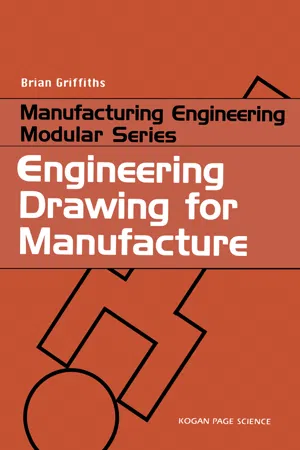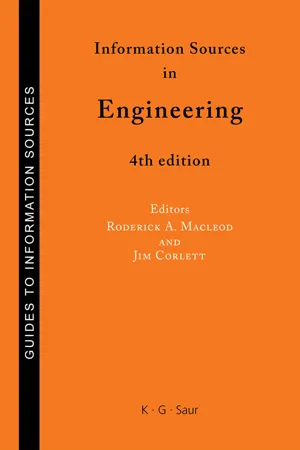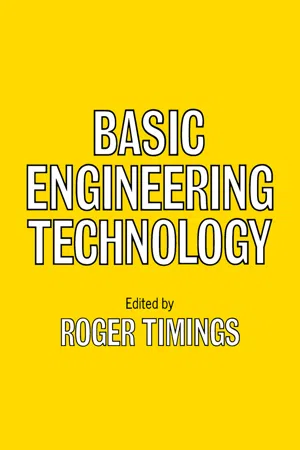Technology & Engineering
BS8888
BS8888 is a British standard that provides guidelines for technical product documentation, including engineering drawings, specifications, and other technical documents. It covers aspects such as drawing layout, dimensioning, tolerancing, and symbols. The standard aims to ensure consistency and clarity in technical communication within the engineering and manufacturing industries.
Written by Perlego with AI-assistance
Related key terms
1 of 5
4 Key excerpts on "BS8888"
- eBook - ePub
- K. L. Richards(Author)
- 2020(Publication Date)
- CRC Press(Publisher)
When BS 8888 was first published, it was originally just a long list of ISO standards and gave virtually no guidance on how to produce a specification. Where BS 308 had provided guidance, explanations and examples on various topics, BS 8888 simply listed the ISO standards which now dealt with that topic. It was in effect just an expensive shopping list.In recent years, BSI has changed their approach. In some ways, BS 8888 has returned to its original BS 308 format and is once again a document which provides rules, definitions and guidance for those involved in creating or interpreting technical specifications.2.2 Classification of Engineering DrawingsThere are a number of different types of engineering drawings, each of which meets a particular purpose. There are typically nine types of drawings in common use which will be discussed in the following sections.2.2.1 A Design Layout Drawing (or a Design Scheme)This type of drawing that is generally to scale depicts the basic layout of a proposed design, meeting the requirements of the design brief. There may be a number of layout drawings covering various proposals.
This drawing is also referred to as a component drawing and contains all the necessary information for the part to be manufactured, e.g., dimensions, tolerances, surface finishes and treatments.2.2.2 A Detailed Drawing
A tabular drawing covers a component that has a common form but can be manufactured in a range of sizes. The variable dimensions are listed in a tabular form.2.2.3 Tabular Drawing2.2.4 Assembly DrawingThis type of drawing shows the individual parts that make up the assembly combined together. Generally, an item list is included on the drawing or is referred to. Only information relating to the assembly is included on the drawing such as fitting instructions or dimensions that must be adhered to are allowed on this type of drawing.2.2.5 Combined DrawingIn some cases this may be drawn as a combined part and assembly drawing together with all the manufacturing details and a tabulated parts list. This type of drawing is restricted to fairly simple type of drawings. - eBook - PDF
- Brian Griffiths(Author)
- 2002(Publication Date)
- Butterworth-Heinemann(Publisher)
The 'XXXX' stands for the number allocated to the standard and the 'YEAR' stands for the year of publication. The standard number bears no relationship to anything; it is effectively selected at random. If a standard has been published before and is updated, the number is the same as the previous number but the 'YEAR' changes to the new year of publication. If it is a new standard it is given a new number. This twofold information enables one to determine the version of a standard and the year in which it was published. When an ISO standard is adopted by the UK, it is given the designation: BS ISO XXXX:YEAR. The BSI has a policy that when any ISO standard is published that is relevant to TPD, it is automatically adopted and therefore rebadged as a British Standard. In this book the term 'engineering drawing' will be used throughout because this is the term which is most likely to be Principles of engineering drawing 3 understood by manufacturing engineering students, for whom the book is written. However, readers should be aware of the fact that the more correct title as far as standards are concerned is TPD. 1.2 The much-loved BS 308 One of the motivating forces for the writing of this book was the demise of the old, much-loved 'BS 308'. This was the British Standard dealing with engineering drawing practice. Many people loved this because it was the standard which defined engineering drawing as applied within the UK. It had been the draughtsman's reference manual since it was first introduced in 1927. It was the first of its kind in the world. It was regularly revised and in 1972 became so large that it was republished in three individual parts. In 1978 a version for schools and colleges was issued, termed 'PD 7308'. Over the years BS 308 had been revised many times, latterly to take account of the ISO drawing standards. - eBook - PDF
- Roderick A. Macleod, Jim Corlett, Roderick A. Macleod, Jim Corlett(Authors)
- 2012(Publication Date)
- De Gruyter Saur(Publisher)
Μ I 04 S T A N D A R D S BSI's standards fulfil the needs of industry and commerce, and protect the rights of consumers. They are essential for public service requirements as well as for individual professional technical responsibilities. British Standards are voluntary, but in certain circumstances, for example when quoted in regulations and legal documents, they become mandatory, e.g. BS 6658:1985 (1995) Specification for protective helmets for vehicle users. There are many categories of standards, the most basic being those of measurement, physical and mechanical data. In each engineering discipline, as they reflect the current state of the art, new editions, new standards and new codes of practice are constantly needed to keep them significant and helpful to users. British standards are issued in a number of series, of which the General Series is of particular importance to the engineer. These standards are generally referred to in the form BS 0 Parts 1-3: 1997, Λ standard for standards, which describes the principles of stan-dardisation, BSI and its committee procedures and the drafting and presentation of standards. The most quoted standards were as follows; BS 308 Part 1: 1972, which now falls into the BS EN ISO series. A guide (PD 308) provides guidance to the European standards for engineering drawing in the BS EN ISO series, BS EN ISO 9000:2000. Quality management and quality assurance standards and also BS EN ISO 14001: 1996 Environmental management systems: specification with guidance for user. Draft standards are available for comment via BSI, London, by letter, telex, and also telephone can be purchased from the BSI sales agents. British Standards can be consulted for reference in more than seventy-six public libraries, universities and polytechnics throughout the United Kingdom, and may be borrowed from the British Library at Boston Spa, Yorkshire. BSI also produce an annual catalogue, a monthly journal called Business Standards, and Update Standards. - eBook - PDF
- R L Timings(Author)
- 2014(Publication Date)
- Butterworth-Heinemann(Publisher)
These are: (a) Terminology and symbols (e.g. drawing con-ventions) (b) Classification and designation (c) Specifications for materials, standard prod-ucts, and processes (d) Methods of measuring, testing, sampling and analysing (e) Recommendations on product or process applications and codes of practice. ISO and BSI standard specifications are the result of consultation and agreement between the inter-ested parties. They only become legally binding if they form part of a contract, or if a claim of compliance is made, or if they are included in legislation. 9.3 Methods of communicating technical information Communications should always be: easy to under-stand and not subject to misinterpretation; suf-ficiently detailed that no additional information needs to be sought; but without repetition and without redundant information which might prove confusing. Technical drawings These may range from preliminary freehand sketches to formal drawings produced to BS 308: 'Engineering drawing practices'. Since technical drawings have to represent three-dimensional solids on a two-dimensional sheet of paper, vari-ous techniques have to be used. These include pictorial views such as isometric and oblique, and INTERPRETING DRAWINGS, SPECIFICATIONS AND DATA I 025 1—012 r—M 12X1.75 R 18 Dimensions in millimetres Material: Free-cutting mild steel DRG No: 4-950-3 A.N.ENGINEERING DRAWING NUMBER J+^SO -3 BATCH 5 MATERIAL MATERIAL SIZE φ 35 (*m bar REMARKS OP. No. I 2 3 ^ 5 * * ^ io 1 l2 fuvjCsK, -soLp odLoLiT . ^A/Y^WC oJJ-borrs . DESCRIPTION OF OPERATION Oac CeAJbrtL-loJüvL . CVvudc bcu Qxre. crvdL· l u m . 2 S nuw. duo^rvefc*/ TuriV f2~ ΓΛ/YV duvr*v«Jocr TWeckA. CVsorrvj«T fc/vjfl. 3 S ov/*-<33EJ &A ctf (Uottse. l/v cVoocic cwi-VvoA o4 iSr>uY duu&ixvAker f o re -bö A X A G ^ K Grxamf*/ DATE REQUIRED 3o/b)n·^ GLOOLA. 0/lo ι*οο «3lO 3Q£> 45 3-Zo ^ Zl*0 — 320 30C FEED mm/rev -ΚΛΛΑ.
Index pages curate the most relevant extracts from our library of academic textbooks. They’ve been created using an in-house natural language model (NLM), each adding context and meaning to key research topics.



